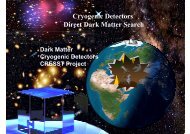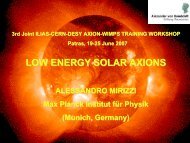The Sun's magnetic field from core to corona
The Sun's magnetic field from core to corona
The Sun's magnetic field from core to corona
You also want an ePaper? Increase the reach of your titles
YUMPU automatically turns print PDFs into web optimized ePapers that Google loves.
<strong>The</strong> Sun’s<br />
Magnetic<br />
Field <strong>from</strong><br />
Core <strong>to</strong><br />
Corona<br />
S.K. Solanki<br />
Max Planck Institute for<br />
Solar System Research
Solar interior:<br />
• Everything below<br />
the Sun’s (optical)<br />
surface<br />
• Divided in<strong>to</strong><br />
hydrogen-burning<br />
<strong>core</strong>, radiative and<br />
convective (energy<br />
transport) zones<br />
Solar atmosphere:<br />
• Directly observable<br />
part of the Sun.<br />
• Divided in<strong>to</strong><br />
pho<strong>to</strong>sphere,<br />
chromosphere,<br />
<strong>corona</strong>,<br />
heliosphere<br />
<strong>The</strong> Sun’s Structure<br />
Convective zone<br />
Radiative zone<br />
Core<br />
Corona<br />
Chromosphere<br />
Surface
Part of<br />
the<br />
Sun in<br />
White<br />
Light<br />
Gas at<br />
5800 K
Gas at 8000 K<br />
(Ca II K)<br />
Chromosphere
<strong>The</strong> Hot and Dynamic Corona<br />
Corona during an Eclipse<br />
EUV Corona: T = 1-2 10 6 K<br />
(different colours mean<br />
different temperatures)
Gas at<br />
10 6 K (Fe<br />
IX 171 Å)<br />
Movie<br />
covers 4<br />
hours<br />
Size of<br />
Earth<br />
A Flare near the Solar Limb
<strong>The</strong> solar physicist’s view:<br />
Sun’s activity is driven by<br />
its <strong>magnetic</strong> <strong>field</strong>
Magnetic<br />
Field<br />
Measured<br />
at Solar<br />
Surface<br />
Sequence of<br />
Magne<strong>to</strong>-<br />
grammes<br />
over a Solar<br />
rotation<br />
MDI/SOHO
Activity Cycle of the Sun<br />
X-Rays<br />
Minimum<br />
Energetic<br />
radiation <strong>from</strong><br />
the Sun varies<br />
by a large<br />
amount over the<br />
solar cycle: by a<br />
fac<strong>to</strong>r of 2 in the<br />
EUV, by a fac<strong>to</strong>r<br />
of 100 in X-rays. X<br />
Maximum<br />
Maximum
Activity Cycle of the Sun<br />
Magnetic Flux<br />
Maximum<br />
Maximum<br />
Minimum<br />
<strong>The</strong> <strong>magnetic</strong><br />
flux of the Sun<br />
also varies over<br />
the 11-year<br />
solar cycle.<br />
At the same<br />
time the number<br />
of sunspots and<br />
other indica<strong>to</strong>rs<br />
of solar activity<br />
also fluctuate.
Magnetic <strong>field</strong> in Sun’s <strong>core</strong> and<br />
radiative zone<br />
• So far only upper bounds<br />
• 7 MG on <strong>to</strong>roidal <strong>field</strong> around <strong>core</strong> <strong>from</strong><br />
oblateness of Sun (Friedland(<br />
and Gruzinov 2004)<br />
• 10 3 -10<br />
4 G on poloidal <strong>field</strong> through <strong>core</strong> <strong>from</strong><br />
asymmetry of solar global dipole at solar surface<br />
(Boyer & Levy 1984; Boruta 1996)<br />
• g-modes: sensitive diagnostics. Possible<br />
discovery reported by Garcia et al. (2007)<br />
• Field strengths of <strong>to</strong>roidal <strong>field</strong>s as low as ~10 4 G<br />
may be detected (Rashba(<br />
et al. 2007)
Flow Fields Relevant <strong>to</strong> Solar Dynamo<br />
Support for an overshoot-layer dynamo (Ω effect)<br />
Large scale flow <strong>field</strong>s: Differential<br />
rotation + meridional circulation<br />
(MDI + GONG)<br />
Small scale flow <strong>field</strong>s:<br />
Convection<br />
(Nordlund<br />
et al.; Miesch)
Sketch of the Solar Dynamo I<br />
Omega effect: winding up<br />
of <strong>field</strong> lines due <strong>to</strong><br />
differential rotation<br />
Emergence of flux due <strong>to</strong><br />
<strong>magnetic</strong> buoyancy once<br />
<strong>field</strong> is strong enough<br />
(Parker instability)
Magnetic <strong>field</strong> in the convection zone<br />
• Magnetic <strong>field</strong> is produced by dynamo located near<br />
bot<strong>to</strong>m of convection zone (in overshoot layer).<br />
<strong>to</strong>roidal<br />
flux tubes in pressure balance with<br />
surroundings:<br />
2<br />
2<br />
B1 B2<br />
+ P = P +<br />
1<br />
8π 8π<br />
• If B 1 > B 2 and T 1 = T 2 , then ρ 1 < ρ 2 intense<br />
<strong>magnetic</strong> <strong>field</strong>s are evacuated and buoyant relative<br />
<strong>to</strong> surrounding gas. Buoyancy dominates over<br />
curvature for B ≥ 10 5 G (Parker instability)<br />
• A loop-like like structure moves <strong>to</strong>wards the solar<br />
surface and breaks out.<br />
2
Sketch of the Solar Dynamo II<br />
Poloidal <strong>field</strong> <strong>from</strong><br />
<strong>to</strong>roidal <strong>field</strong>: α-effect<br />
(due <strong>to</strong> Coriolis force)<br />
New poloidal <strong>field</strong> has<br />
opposite polarity <strong>to</strong><br />
original poloidal <strong>field</strong>
Emergence of a <strong>magnetic</strong> flux tube<br />
Magnetic <strong>field</strong> is believed <strong>to</strong> be generated mainly in the<br />
Tachocline near bot<strong>to</strong>m of convection zone.<br />
Due <strong>to</strong> its buoyancy (see earlier slide; Parker instability), a<br />
<strong>magnetic</strong> <strong>field</strong> will rise <strong>to</strong>wards the solar surface. At the solar<br />
surface it will produce a bipolar active region.
Change of B-<strong>field</strong> with height<br />
• Plasma β describes the ratio of<br />
thermal <strong>to</strong> <strong>magnetic</strong> energy density:<br />
8πP<br />
β =<br />
2<br />
B<br />
• β >1 <strong>The</strong>rmal energy, i.e. gas dominates & forces<br />
the <strong>field</strong> <strong>to</strong> follow: in solar interior<br />
• β < 1 Magnetic <strong>field</strong> dominates and dictates the<br />
dynamics of the gas: in atmosphere, <strong>corona</strong>: β ≈ 10<br />
• B ≈ 1500 G at solar surface, B ~ exp(-z/<br />
z/2H),<br />
due <strong>to</strong><br />
horizontal pressure balance and P g ~ exp(-z/H<br />
z/H)<br />
• Due <strong>to</strong> flux conservation,<br />
∫∫ B(<br />
x,<br />
y,<br />
z)<br />
dxdy = const<br />
<strong>field</strong> expands exponentially with height, until it fills<br />
all the available space above a given height.<br />
10 -3
Flux Tubes, Canopies, Loops and<br />
Funnels
Coronal Heating: Driven by<br />
Magne<strong>to</strong>convection?<br />
Energy dissipation &<br />
magn. . reconnection<br />
at current sheets<br />
<br />
Complex & tangled<br />
<strong>corona</strong>l <strong>magnetic</strong><br />
structure<br />
<br />
Dynamic interaction<br />
of <strong>magnetic</strong> flux<br />
with convection
First measurement of the <strong>magnetic</strong><br />
<strong>field</strong> in <strong>corona</strong>l loops<br />
Magnetic loops<br />
deduced <strong>from</strong><br />
measurements<br />
of He I 10830 Å<br />
S<strong>to</strong>kes profiles in<br />
an emerging flux<br />
region.<br />
Left projection:<br />
Field strength<br />
Right projection:<br />
Vertical velocity<br />
Solanki et al.<br />
2003, Nature
Magnetic reconnection
Evidence for reconnection<br />
Innes et al. 1998, Nature<br />
Reconnection<br />
Observer
Electric Current Sheet at Coronal Base<br />
He I 10830 Å reveals electric current sheet (tangential<br />
discontinuity of <strong>magnetic</strong> vec<strong>to</strong>r) at <strong>corona</strong>l base<br />
Solanki et al. 2003, Nature<br />
Observed in<br />
emerging flux<br />
region<br />
Surface:<br />
<strong>magnetic</strong> <strong>field</strong><br />
strength (note the<br />
valley)<br />
Colour: current<br />
density






